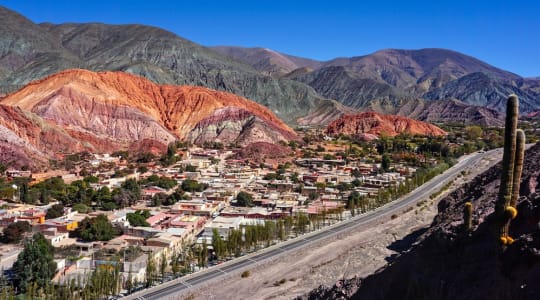Cerro de los Siete, known as the "Hill of the Seven Colors," is a notable geographical landmark located in the Patagonian region of South America, spanning both Argentina and Chile. This distinctive hill has earned its name due to the mesmerizing array of colors displayed across its slopes, making it a captivating natural wonder.
Situated in the Argentine province of Jujuy, Cerro de los Siete is part of the Quebrada de Humahuaca valley, a UNESCO World Heritage Site celebrated for its rich cultural heritage and striking landscapes. The hill's geological formation is a product of millions of years of natural processes, revealing layers of sedimentary rock, including shale, limestone, and sandstone. These layers, when exposed, create a visual spectacle with hues ranging from reds and purples to greens and yellows.
Cultural significance is deeply intertwined with Cerro de los Siete. Indigenous communities in the region have a profound connection to the land and the colorful hills, often featuring them in their traditions and folklore. This area is not only renowned for its geological beauty but also for its role in preserving the cultural heritage of the local inhabitants.
Tourism has flourished around Cerro de los Siete, with visitors coming from all corners of the globe to experience its natural wonder. Travelers can explore the surrounding region, hike its rugged terrain, capture photographs of the striking landscapes, and immerse themselves in the unique atmosphere of the Quebrada de Humahuaca.
Beyond its geological and cultural significance, the area surrounding Cerro de los Siete is home to a diverse range of flora and fauna, adapted to the challenging semi-arid Andean highlands. Researchers and nature enthusiasts are drawn to this region to study the unique ecosystems and wildlife that thrive in this environment.
Conservation efforts are underway to balance the increasing demands of tourism with the imperative to protect the fragile ecosystems and indigenous heritage of the region. Cerro de los Siete serves as a symbol of the delicate balance between human activity and the preservation of natural beauty and cultural heritage.
Explore Near Cerro de los Siete Colores
Discover 1 attraction and 1 city within 75km. Perfect for planning day trips, finding connecting flights, or discovering new destinations to explore during your visit.
Nearby Attractions & Places to Visit
1 destination within 62.8km from your location

Nearby Cities Worth Exploring
1 destination within 54.0km from your location
Cross-Border Adventures Near Cerro de los Siete Colores
Discover cross-border adventures near Cerro de los Siete Colores. Explore neighboring countries with similar attractions and extend your travel experience across borders.





